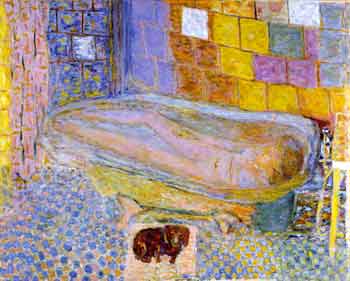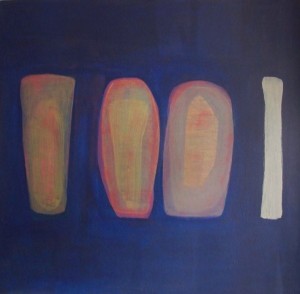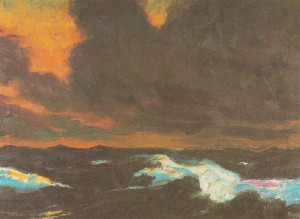In this episode, the patron of the society Iain McGilchrist, talks about his book The Master and his Emissary, the value of the arts, his views on, awe, modernity and religion and how he feels his work relates to the Middle Way.

In this episode, the patron of the society Iain McGilchrist, talks about his book The Master and his Emissary, the value of the arts, his views on, awe, modernity and religion and how he feels his work relates to the Middle Way.
Pierre Bonnard, 1867 – 1947.
Pierre Bonnard belonged to a group of painters who were known as The Nabis. The word nabi is Hebrew for prophet ‘inspired to speak the word of God’ The group worked together from 1900 to 1906, when they split up.
I have admired the work of the French painter Bonnard for many years, long before I learnt about the Nabis and their contemporaries. I would walk from our home south of the river, to visit the Tate Gallery and would gaze at The Bonnard painting he did of his wife Marthe in her bath. Pierre Bonnard is accessable as a painter, which is probably why I liked his work so much, but in fact these painters in the group were to influence Cubist painters who worked later. He borrowed lightness from the Impressionists, the bold colours of the Post Impressionists and the Fauves, he filled his work with his own intensity.The group was aware of Japanese prints, as were many painters at the time, such as Van Gogh, they also liked Art Nouveau, which was especially popular in Paris for a short time, until Art Deco arrived on the scene.
One of the group, Maurice Denis, worte that ‘the canvas is a flat surface covered with colours, assembled in a certain order’, while Eduard Vuillard wrote ‘who speaks of art speaks of poetry’. What concerned them was individuality, using pure colour organisation and form. Denis said he didn’t paint portraits, he painted people in their home. I understand the difference.
The Nabis explored the daily scene, using symbols we understand, not in the way the Impressionists had when they captured ephemeral light, but they looked back to traditional values, for a static and unchanging conception of reality. Their critics thought the work was a regressive form of painting, which ignored the achievements of the Impressionist painters. The Nabis rejected the painting theories of their tutors, which they considered to be materialistic, the Nabis aimed to use colour and design, to bring about harmony and balance – the goals of Classicism.
Bonnard spent his working life ‘exploring and analysing the process of seeing and looking and so translating ways in which visual perceptions interlock with the process of memory.’ Nicholas Serota.
To return to the painting of Marthe in the bath, the painting glows with yellow, the bath is a ‘porcelian tomb made incadescent by the gold and violet light, reflecting off the surfaces of the tiles and the water’. The use of complementry colours makes them zing, Matisse and Van Gogh, to name two painters, used the same technique.The subject matter in Bonnard’s work is I find, comforting, not sentimental though, their dog would often feature in his work, every day situations were captured, sitting in the garden drinking tea, laying a table for a meal, three generations painted in a triangular composition, grandmother,  mother and baby. His self portraits were different, searing and strong, to be compared favourbly with those of Van Gogh and Rembrandt. Bonnard would often mix up perspective, a table for example would be on a different plane, to show what lay on it more fully, he used geometry and perspective in order to obtain the effect he sought. I think he succeeds in integrating art and every day life.
mother and baby. His self portraits were different, searing and strong, to be compared favourbly with those of Van Gogh and Rembrandt. Bonnard would often mix up perspective, a table for example would be on a different plane, to show what lay on it more fully, he used geometry and perspective in order to obtain the effect he sought. I think he succeeds in integrating art and every day life.
In response to Robert’s reply, I have read more about the work of the Die Brucke group of artists. I’m not sure in which way their work brings to us to integration, perhaps the new symbols, violent images, in their work, send a prophetic warning of the horrors to come in two world wars. The new symbols created became a language of violence. Nolde was a visionary, he felt the inter -dependence of art and nature, his stormy sea paintings were filled with energy,
E L Kirchner, 1880-1938, wrote that the group aimed ‘ to eschew the prevalent traditional academic style…..’ He used old techniques like wood cuts in a dynamic way, while always remembering the old Masters like Durer, Cranach and Grunewald and the art of Africa and Oceanic art, which were becoming more widely known in Europe. Kirchner was deeply affected by the first World War, though too sickly to fight, he did driving work, when a new war loomed in 1938 he shot himself, he feared war so intensely. The Nazis confiscated his work. He understood the dark side of life and yet he inhabited the intensity of colour he used in paintings, the reds, yellows and blues, primary colours, and light, as did Van Gogh.
I can see how depression comes about by having an ‘isloated, unintegrated left hemishphere’, I facetiously equated unintegrated with unhinged! Munch had a childhood which seemed to be filled with dying relatives,it must have impacted on his thinking.
Art as a preventative practice against mental breakdown makes sense to me, I also think that the work which art therapists do with prisoners, also shows how people can channel their destructive, anti -social behaviour into positive behaviour, so diverting energy in a more beneficial way.
Herbert Read in his book ‘The Meaning of Art’ writes, ‘expressionism is a distinct movement in modern art, it arose spontaneously as a manifestation of artists and a group of artists in Germany ,in the decade before the first world war, was it a sign of the times? In France, the Fauves were not as violent in expression, but the need for change also existed.
I listened to Robert Plinsky reciting Donne’s Nocturnal on St lucie’s Day, beautiful sombre and emotionally charged. I can see how an isolated left hemisphere has a detrimental effect, art to avoid mental breakdown seems right to me.
I’m aware of the vast difference between depression and melancholy, having experienced both. With help, depression became a thing of the past some decades ago , but when one of my twin sons died in a paragliding accident in 2000, I knew melancholy all too well.  Without being barely conscious of what I was doing, I painted about twenty canvases over the following few months, geometric patterns, using mostly staight lines, concentrating on the mixing of colours, to fill the shapes, totally absorbed me. I also was reminding myself of Impermanence and the Four Truths, I painted a canvas with four coffin-shaped images, when I finished it I realised that the painting was an expression of my grief.
Without being barely conscious of what I was doing, I painted about twenty canvases over the following few months, geometric patterns, using mostly staight lines, concentrating on the mixing of colours, to fill the shapes, totally absorbed me. I also was reminding myself of Impermanence and the Four Truths, I painted a canvas with four coffin-shaped images, when I finished it I realised that the painting was an expression of my grief.
I then went on to paint more abstract images. The ferocity of pain became integrated, I found myself in a calmer place. Writing, visual art and music all have a similar role I think.
Given that a focus on the arts is part of an integrative practice especially in regard to meaning, this is a regular slot in which a poem can be reflected upon. How it makes you feel, what it says to you and what connection (if any) you can make with the Middle Way.
If there is a poem that you would like to suggest for this section, send it to me at barry@middlewaysociety.org and say in what way you feel it is meaningful to you.
Snake
A snake came to my water-trough
On a hot, hot day, and I in pyjamas for the heat,
To drink there.
In the deep, strange-scented shade of the great dark carob-tree
I came down the steps with my pitcher
And must wait, must stand and wait, for there he was at the trough before
me.
He reached down from a fissure in the earth-wall in the gloom
And trailed his yellow-brown slackness soft-bellied down, over the edge of
the stone trough
And rested his throat upon the stone bottom,
And where the water had dripped from the tap, in a small clearness,
He sipped with his straight mouth,
Softly drank through his straight gums, into his slack long body,
Silently.
Someone was before me at my water-trough,
And I, like a second comer, waiting.
He lifted his head from his drinking, as cattle do,
And looked at me vaguely, as drinking cattle do,
And flickered his two-forked tongue from his lips, and mused a moment,
And stooped and drank a little more,
Being earth-brown, earth-golden from the burning bowels of the earth
On the day of Sicilian July, with Etna smoking.
The voice of my education said to me
He must be killed,
For in Sicily the black, black snakes are innocent, the gold are venomous.
And voices in me said, If you were a man
You would take a stick and break him now, and finish him off.
But must I confess how I liked him,
How glad I was he had come like a guest in quiet, to drink at my water-trough
And depart peaceful, pacified, and thankless,
Into the burning bowels of this earth?
Was it cowardice, that I dared not kill him? Was it perversity, that I longed to talk to him? Was it humility, to feel so honoured?
I felt so honoured.
And yet those voices:
If you were not afraid, you would kill him!
And truly I was afraid, I was most afraid, But even so, honoured still more
That he should seek my hospitality
From out the dark door of the secret earth.
He drank enough
And lifted his head, dreamily, as one who has drunken,
And flickered his tongue like a forked night on the air, so black,
Seeming to lick his lips,
And looked around like a god, unseeing, into the air,
And slowly turned his head,
And slowly, very slowly, as if thrice adream,
Proceeded to draw his slow length curving round
And climb again the broken bank of my wall-face.
And as he put his head into that dreadful hole,
And as he slowly drew up, snake-easing his shoulders, and entered farther,
A sort of horror, a sort of protest against his withdrawing into that horrid black hole,
Deliberately going into the blackness, and slowly drawing himself after,
Overcame me now his back was turned.
I looked round, I put down my pitcher,
I picked up a clumsy log
And threw it at the water-trough with a clatter.
I think it did not hit him,
But suddenly that part of him that was left behind convulsed in undignified haste.
Writhed like lightning, and was gone
Into the black hole, the earth-lipped fissure in the wall-front,
At which, in the intense still noon, I stared with fascination.
And immediately I regretted it.
I thought how paltry, how vulgar, what a mean act!
I despised myself and the voices of my accursed human education.
And I thought of the albatross
And I wished he would come back, my snake.
For he seemed to me again like a king,
Like a king in exile, uncrowned in the underworld,
Now due to be crowned again.
And so, I missed my chance with one of the lords
Of life.
And I have something to expiate:
A pettiness.
D. H. Lawrence
 The Die Brucke group of Painters.
The Die Brucke group of Painters.
In a working class area of Dresden, Germany in 1905, a group of ex-architecture students got together to form a community of painters, rather in the way that the Guilds of The Middle Ages operated. Members of the group were Heckel, Kirchner, Pechstein, Schmidt-Rottluuf and for a short time Emil Nolde.
Emil Nolde 1867-1956, soon left the group to go travelling around Europe, he preferred solitude to work on his paintings, they show an integrated vision of the world, that celebrated a love of nature and all that was around him?
In 1930 he painted a series of paintings which he named The Sea. He worked on the island of Sylt, Germany. He wrote, ‘I had a wish to live and paint as alone as possible, only observing and in particular, I wanted to see the sea again, in all it’s wild greatness. His work portrays a savage wildness.
I love to paint the sea, aware of its constant ebb and flow, with huge skies that tower above, often filled with ever changing cloud patterns.
These painters have influenced future paintings in many ways, for example Expressionist painters in the 20th.century, such as Edvard Munch, who painted The Scream and The Sick Child. He wrote ‘there must be living beings painted, who breathe and feel and love and suffer’. His work displays these emotions. Violent distortion and execution of colour were used to express deep or violent emotions – not simply painting what the eye can see.
I wonder if these paintings absorb such emotions, neutralise them? Robert Ellis writes: ‘integration needs to be described in terms of psychological states, rather than just in terms of philosophical analysis of meaning’.
I would welcome your views please.